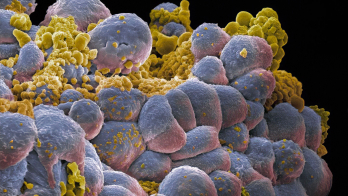
The Synchrotron-light for Experimental Science and Applications in the Middle East (SESAME) is a 2.5 GeV third-generation synchrotron radiation (SR) source developed under the auspices of UNESCO and modelled after CERN. Located in Allan, Jordan, it aims to foster scientific and technological excellence as well as international cooperation amongst its members, which are currently Cyprus, Egypt, Iran, Israel, Jordan, Pakistan, Palestine and Turkey. As a user facility, SESAME hosts visiting scientists from a wide range of disciplines, allowing them to access advanced SR techniques that link the functions and properties of samples and materials to their micro, nano and atomic structure.
The location of SESAME is known for its richness in archaeological and cultural heritage. Many important museums, collections, research institutions and universities host departments dedicated to the study of materials and tools that are inextricably linked to prehistory and human history, demanding interdisciplinary research agendas and teams. As materials science and condensed-matter physics play an increasing role in understanding and reconstructing the properties of artefacts, SESAME offers a highly versatile tool for the researchers, conservators and cultural-heritage specialists in the region.
The high photon flux, small source size and low divergence available at SR sources allow for advanced spectroscopy and imaging techniques that are well suited for studying ancient and historical materials, and which often present very complex and heterogeneous structures. SR techniques are non-destructive, and the existence of several beamlines at SR facilities means that samples can easily be transferred and reanalysed using complementary techniques.
SESAME offers a versatile tool for researchers, conservators and cultural-heritage specialists in the region
At SESAME, an infrared microspectroscopy beamline, an X-ray fluorescence and absorption spectroscopy beamline, and a powder diffraction beamline are available, while a soft X-ray beamline called “HESEB” has been designed and constructed by five Helmholtz research centres and is now being commissioned. Next year, the BEAmline for Tomography at SESAME (BEATS) will also be completed, with the construction and commissioning of a beamline for hard X-ray full-field tomography. BEATS involves the INFN, The Cyprus Institute and the European SR facilities ALBA-CELLS (Spain), DESY (Germany), ESRF (France), Elettra (Italy), PSI (Switzerland) and SOLARIS (Poland).
To explore the potential of these beamlines, the First SESAME Cultural Heritage Day took place online on 16 February with more than 240 registrants in 39 countries. After a welcome by SESAME director Khaled Toukan and president of council Rolf Heuer, Mohamed ElMorsi (Conservation Centre, National Museum of Egyptian Civilization), Marine Cotte (ESRF) and Andrea Lausi (SESAME) presented overviews of ancient Egyptian cultural heritage, heritage studies at the ESRF, and the experimental capabilities of SESAME, respectively. This was followed by several research insights obtained by studies at SESAME and other SR facilities: Maram Na’es (TU Berlin) showed the reconstruction of colour in Petra paintings; Heinz-Eberhard Mahnke and Verena Lepper (Egyptian Museum and Papyrus Collection, FU/HU Berlin and HZB) explained how to analyse ancient Elephantine papyri using X-rays and tomography; Amir Rozatian (University of Isfahan) and Fatma Marii (University of Jordan) determined the material of pottery, glass, metal and textiles from Iran and ancient glass from the Petra church; and Gonca Dardeniz Arıkan (Istanbul University) provided an overview of current research into the metallurgy of Iran and Anatolia, the origins of glassmaking, and the future of cultural heritage studies in Turkey. Palaeontology with computed tomography and bioarchaeological samples were highlighted in talks by Kudakwashe Jakata (ESRF) and Kirsi Lorentz (The Cyprus Institute).
During the following discussions, it was clear that institutions devoted to the research, preservation and restoration of materials would benefit from developing research programmes in close cooperation with SESAME. Because of the multiple applications in archaeology, palaeontology, palaeo-environmental science and cultural heritage, it will be necessary to establish a multi-disciplinary working group, which should also share its expertise on practical issues such as handling, packaging, customs paperwork, shipping and insurance.







